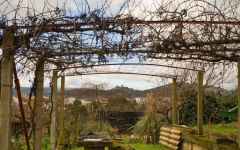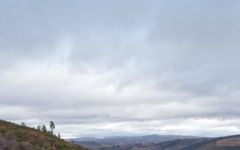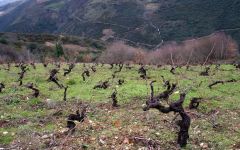Quinta da Muradella Alanda Tinto 2013
-
Wine &
Spirits -
Robert
Parker



Product Details
Your Rating
Somm Note
Winemaker Notes
The different grape varieties were fermented together, part in stainless steel, part in cement, with one third of full clusters and aged for one year in used barrels and matured for a further three months in stainless steel before being bottle unfiltered. The nose is fruit-driven, there are no traces of oak, a combination of cherry fruit, herbal aromas and a pinch of spices, and a medium-bodied palate with focused, red cherry flavors, fine tannins and balanced acidity. This is supple and easy to drink, fresh and very pleasant.
Professional Ratings
-
Wine & Spirits
This is a blend from vineyards planted between 1942 and 2002—mostly mencía (65 percent) and bastardo (30 percent) with a little tinto fino. The result is complex, refreshing and delicious, with earthy flavors of fungi, red fruits and herbs. It gives a sense that there are many more layers to discover and that it will take some time in the bottle for this wine to undress. For the moment, the vibrant and refreshing red fruit flavors that winegrower José Luis Mateo obtains from high altitudes in Monterrei are seductive enough not to wait: You could decant this bottle now to enjoy with grilled sardines.
-
Robert Parker's Wine Advocate
The red 2013 Alanda, cropped from a coolish vintage with some rains at the end of the harvest is a blend of grapes and origins within Monterrei, Mencía, Bastardo, Garnacha Tintorera, Mouraton, Gran Negro and Arauxa. The grapes were fermented together, part in stainless steel and part in concrete, with some full clusters. Part of the wine matured in used barriques for 14 months while part rested in the concrete vats. The two parts were blended and kept in cement for three months before being bottled. It's an Alanda with nerve and tension, with aromas of bitter cherries and aromatic herbs with just a touch of spices. The palate is vibrant and sharp, with very good acidity; there is a fine thread and polished tannins, but with nerve and grip. It was bottled unfiltered. All these wines are still showing very young, and will benefit from at least six months in bottle.
Other Vintages
2016-
Robert
Parker -
Wine &
Spirits

With hundreds of red grape varieties to choose from, winemakers have the freedom to create a virtually endless assortment of blended red wines. In many European regions, strict laws are in place determining the set of varieties that may be used, but in the New World, experimentation is permitted and encouraged resulting in a wide variety of red wine styles. Blending can be utilized to enhance balance or create complexity, lending different layers of flavors and aromas. For example, a red wine blend variety that creates a fruity and full-bodied wine would do well combined with one that is naturally high in acidity and tannins. Sometimes small amounts of a particular variety are added to boost color or aromatics. Blending can take place before or after fermentation, with the latter, more popular option giving more control to the winemaker over the final qualities of the wine.
How to Serve Red Wine
A common piece of advice is to serve red wine at “room temperature,” but this suggestion is imprecise. After all, room temperature in January is likely to be quite different than in August, even considering the possible effect of central heating and air conditioning systems. The proper temperature to aim for is 55° F to 60° F for lighter-bodied reds and 60° F to 65° F for fuller-bodied wines.
How Long Does Red Wine Last?
Once opened and re-corked, a bottle stored in a cool, dark environment (like your fridge) will stay fresh and nicely drinkable for a day or two. There are products available that can extend that period by a couple of days. As for unopened bottles, optimal storage means keeping them on their sides in a moderately humid environment at about 57° F. Red wines stored in this manner will stay good – and possibly improve – for anywhere from one year to multiple decades. Assessing how long to hold on to a bottle is a complicated science. If you are planning long-term storage of your reds, seek the advice of a wine professional.

The Monterrei wine region in the northwestern region of Galicia on the border of Portugal takes its name from 'Monterrey', which means “the king's mountain” in Castilian; Monterrei is the Galician spelling. The hilltop fortress of the area overlooks the vineyards, which run north to south. Compared to other regions, the area was awarded DO status later, in 1996, although it had won provisional DO status in the 1970s.
There is a slow comeback of native grapes and winemaking styles like those in other parts of Galicia—fresh, fruity white wines and young Mencía-based red wines. While there is new investment coming into the region's small family and cooperative bodegas, much of the wine is still sold in bulk and work with native varieties is still in the early stages, but pioneering bodegas are showing the potential of the vineyards. The DO supports this by awarding the Monterrei Superior label to wines made with 85% of any native variety.
The principal white wine varieties are Doña Blanca, Godello and Treixadura while the red wines are made primarily from Mencía and Bastardo (Trousseau).






